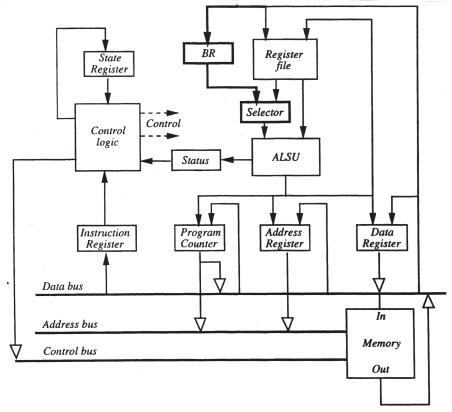EECS 31/CSE 31/ICS 151 Homework 8 Questions with Solutions
View Questions Only
View Questions with Strategies
Problem 1
Question
(Instruction formats) Write a sequence of instructions that will compute the value of y = x2 + 2x + 3 for a given x using
- three-address instructions
- two-address instructions
- one-address instructions
Solution
-
three-address instructions
Mult z, x, x Mult y, 2, x Add y, y, z Add y, y, 3 -
two-address instructions
Move z, x Mult z, x Move y, 3 Add y, z Move z, x Mult z, 2 Add y, z -
one-address instructions
Move x Mult x Store z Move x Mult 2 Add z Add 3 Store y
Problem 2
Question
(Addressing modes) Write procedures for reading from and writing to a FIFO queue, using a two-address format, in comjunction with:
- indirect addressing
- relative addressing
Solution
-
Reading: Loadindirect R3, R1 Inc R1 Writing: Storeindirect R2, Data Inc R2 -
if we have a fixed base register called BR:
Reading: Move temp, BR Move BR, R1 Loadrel R4, offset Inc R1 Move BR, temp Writing: Move temp, BR Move BR, R2 Storerel offset, Data Inc R2 Move BR, temp
Problem 3
Question
(Addressing modes) Write a sequence of instructions that will compute  aixi where A = [a1, a2, ..., a100] and X = [x1, x2, ..., x100] represent arrays that are stored in the main memory. Use two-address instructions, in conjunction with:
aixi where A = [a1, a2, ..., a100] and X = [x1, x2, ..., x100] represent arrays that are stored in the main memory. Use two-address instructions, in conjunction with:
- direct addressing
- relative addressing
- indexed addressing with an auto-increment mode
Solution
-
Direct addressing:
Move Sum, 0 Load Temp1, 1000 Load Temp2, 2000 Mult Temp1, Temp2 Add Sum, Temp1 ... Load Temp1, 1099 Load Temp2, 2099 Mult Temp1, Temp2 Add Sum, Temp1 -
relative addressing
Move Sum, 0 Loadrel Temp1, 0 Loadrel Temp2, 100 Mult Temp1, Temp2 Add Sum, Temp1 ... Loadrel Temp1, 99 Loadrel Temp2, 199 Mult Temp1, Temp2 Add Sum, Temp1 -
indexed addressing with an auto-increment mode
Move Sum, 0 Move IR, 0 L1: Loadindex Temp1, 1000 Loadindex Temp2, 2000 Mult Temp1, Temp2 Add Sum, Temp1 Cmp IR, 100 Bne L1
Problem 4
Question
(Instruction set) Add a dedicated base register ( BR ) to the 16-bit processor shown in Figure 9.9, and then show the changes this requires in the instruction set and the processor schematic.
Solution
Add one instruction to load the base:
Lbase Address : BR <-- Address
Change relative addressing:
Lrel Dest, Base : RF[Dest] <-- Mem[BR + Offset]
Srel Srcl, Base : Mem[BR + Offset] <-- RF[Srcl]
The processor would need to be modified in the following manner:

Problem 5
Question
(Reduced instruction set) Using the instruction set presented in Figure 9.11, propose the changes that enable it so to accommodate a register file with:
- 16 registers
- 32 registers
- 64 registers
- 256 registers
Solution
- (a, b) Four bits are required to address 16 registers, and five bits are needed to address 32 registers. The simplest change to the instruction set would be to reduce the size of the constant and offset fields by three bits to increase the bits used in the register fields.
- (c, d) For larger register files, simply reducing the offset and constant fields will not be enough. Register instructions can altered by either removing the constant field or by assuming that one of the Src fields also acts as the Dest frees up bits.
- Memory instructions to load and store relative to some address can be changed through the inclusion of a base register and removal of the Src2 field.
- The branching instruction can be divided into two instructions, a comparison instruction and a branch instruction based upon a status register.
Problem 6
Question
(IS flowchart) Develop an IS flowchart for the reduced instruction set presented in Figure 9.11.
Solution

Problem 7
Question
(Branch prediction) Write a program that will compute absolute value for the RISC processor shown in Figure 9.12. Develop a timing diagram for this processor,
- without branch prediction
- with branch prediction
Solution
-
To realize this algorithm using our RISC instructions on the processor without branch prediction, we could program it as follows:
Address Instruction 100 Bgeq a, 0, +9 101 N o - op 102 N o - op 103 N o - op 104 sub val, 0, a 105 jump + 5 106 N o - op 107 N o - op 108 N o - op 109 N o - op 110 ... Timing diagram when branch is not taken ( a < 0 )

Timing diagram when branch is taken ( a >= 0)

-
The program would change slightly when tuned for the processor with branch prediction
Address Instruction 100 Bgeq a, 0, +3 101 sub val, 0, a 102 jump + 2 103 mov val, a 104 ... Timing diagram when branch is not taken ( a < 0 )

Timing diagram when branch is taken ( a >= 0 )
